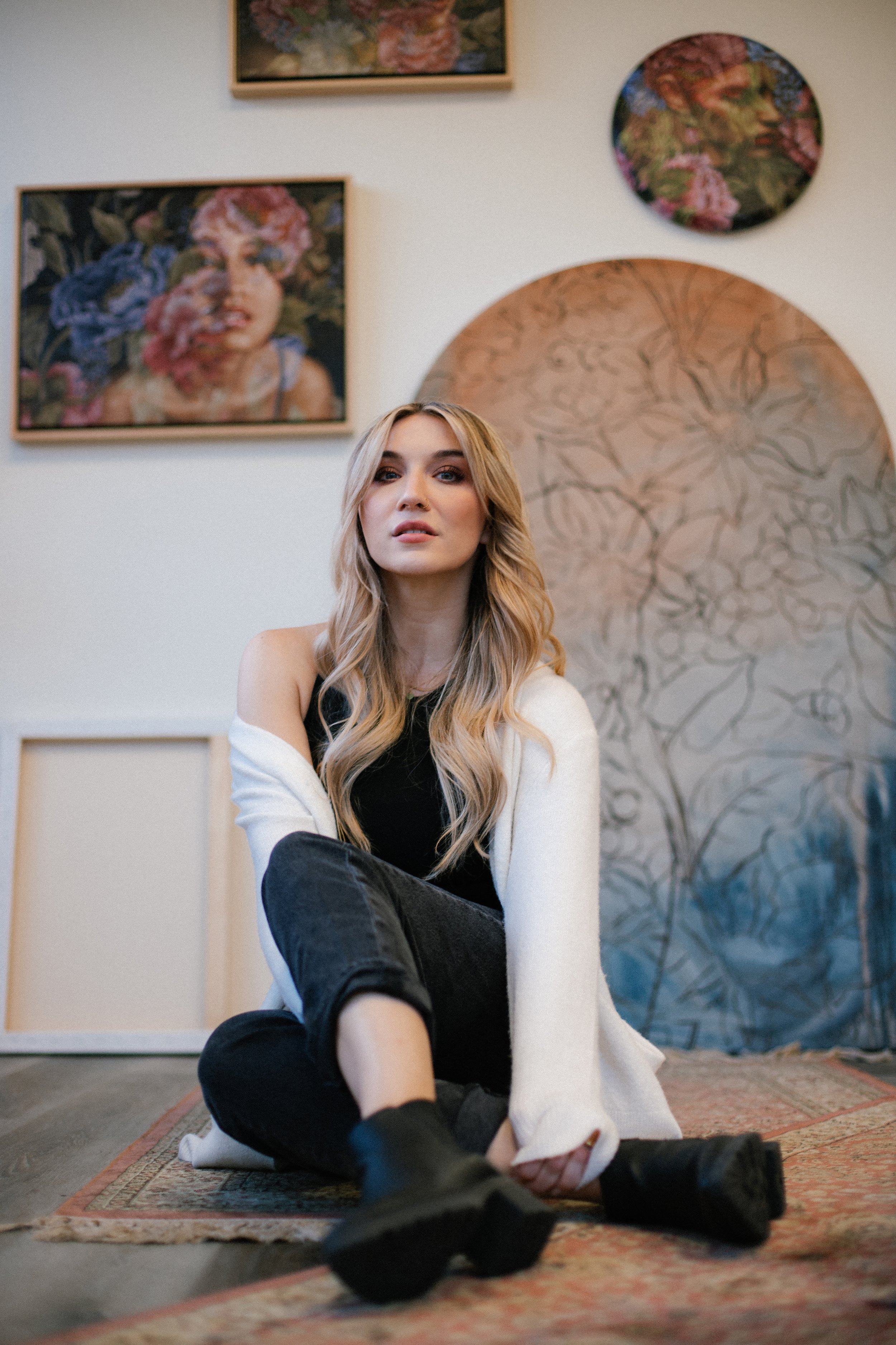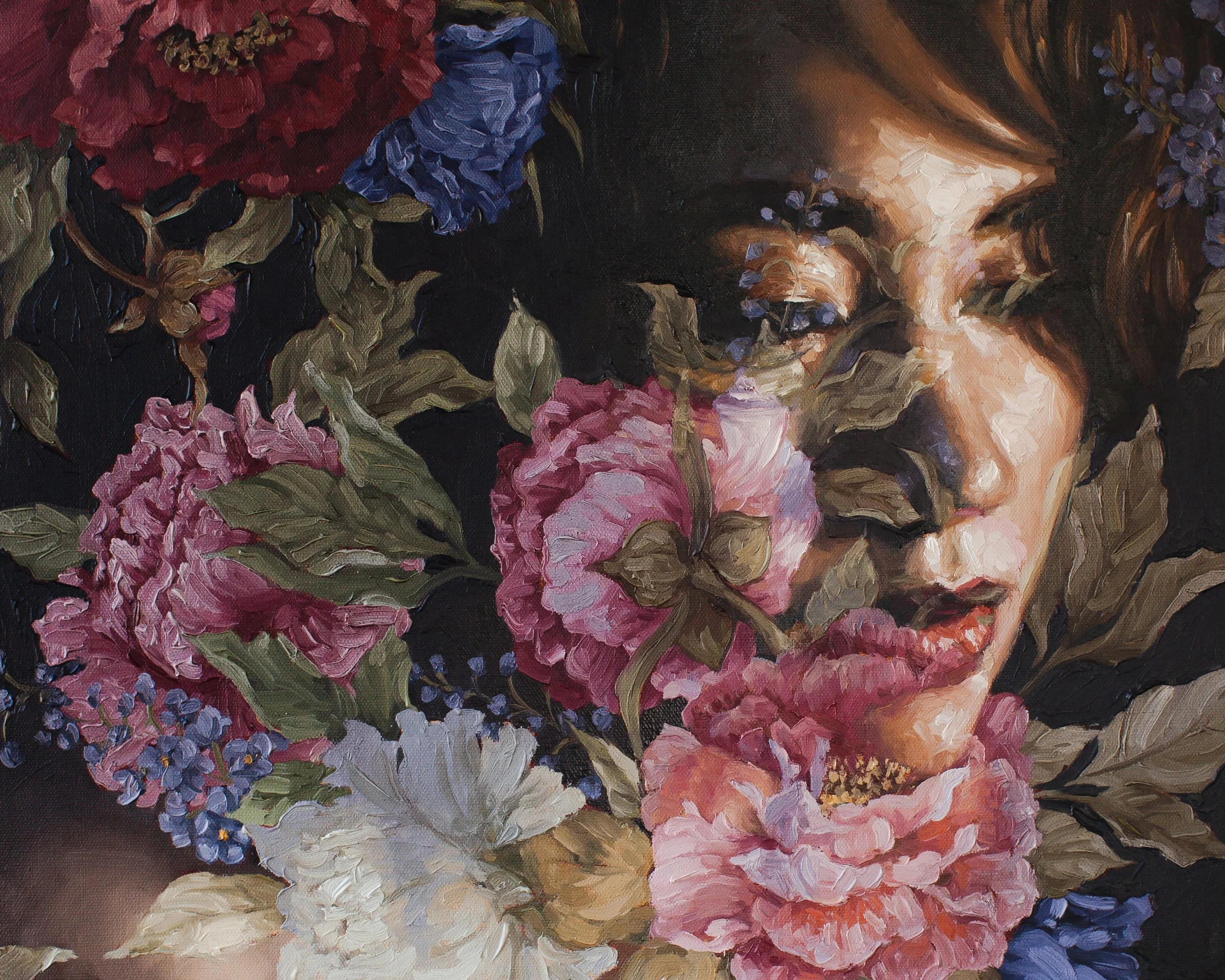Transcending the Image

Transcending the Image
An Interview with Jess Velarde by Julia Bartel
Jess Velarde knew that she wanted to be a painter at age five.
Even so, she spent much of her early adulthood not painting at all. “I wasn’t good at it because I didn’t do it very much,” Verlarde says. “I could not bear the weight of not being good at something that I loved so much and wanted to do so badly.”
Not good is hardly a phrase anyone would use to describe Velarde’s work. Without seeing the years of struggle, endurance, and commitment to mastery she’s walked through, you might happen across a painting of hers and assume that it simply emerged from her brush, fully formed and seemingly perfect. Such work is the fruit born from knowing exactly where her calling lies.
“It’s weird how you can feel that very distinct, clear calling,” she says. Her tone is pensive as she imagines the siren song of creative inspiration in her life. “It pursues you. It’s calling to you. There’s something about creative work that does that in such a particular way. But you can’t know how much something is calling to you until you try something that isn’t.”
Velarde tried—that is, tried something that wasn’t her calling. For years, she circled around her dream of becoming a painter by making a living off other creative pursuits: wedding photography, graphic design, art direction and branding, project management, and even starting a YouTube channel (which, she says, you will never find). This work was not what she really loved: “None of it brought me to life in the way that painting did.”
*
One afternoon in a work meeting, Velarde prayed. “I told God—look, I know this is not what I’m supposed to be doing with my life. But I really like this job. I don’t know how I’m going to leave it, but I know I’m supposed to paint. So you’re gonna have to figure it out for me.” Velarde was let go hours later.
From there, Velarde earned her MFA at Academy of Art University in San Francisco and is now in her second year of working full-time as a painter. Her studio—or what I can see of it through a webcam—is filled with natural light; behind her is a shelf holding frames, cups of brushes, boxes and hanging plants, monstera leaves in a pot, and an unfinished half-painted canvas perched on an easel. Gazing into her world through my computer screen, as if through a magic mirror, I am enchanted by the life she has built for herself by doing what so many creatives long to do: dedicating herself to the work.
*
“Talent is kind of a myth,” Velarde says. “Ninety-five percent of it is work… so many people don’t get there because they think they’re not innately good at it.” Instead, she says, all of the world’s greatest artists got there because “they worked really hard for a really long time. You have to make bad art to make good art.”
Jess Velarde
I have heard that bad art is bad when it is fundamentally untrue. Either it lacks an honest emotional resonance or it preaches a message rather than exploring beauty and mystery. According to Velarde, learning to make good art—in her words, “learning how to let the truth come through in your voice”—is a skill that takes practice. “The way you get there is just to keep going…the end result doesn’t matter at all. The process is what matters. The more you practice, the better the product will be. But you won’t practice enough to create a good product if you’re focusing on the product.” If you allow yourself to give in to the process, “it will free you and equip you to create the best work of your life again and again, and you’ll enjoy that journey so much more.”
In addition to the paintings featured in Velarde’s website highlights, which she deems as the works “that might be good enough to sell,” are well over fifty other paintings that she hasn’t publicly shared, including earlier paintings and other studies. “The amount of hours that I’ve put in to get to do this—hundreds. Probably thousands.” This holds true for any artist. Velarde believes that the act of making art shouldn’t be approached as a magical process reserved for those with inborn talent. Rather, it’s for those who are willing to cultivate a skill. “There are issues of accessibility, privilege, time, resources, and oppression that come into play,” she says. “But in terms of what is possible, anyone can do creative work.”
*
Velarde describes the tension she held, early on in her career, of integrating her art with her faith—could she make art that met practical needs and encouraged others to follow Jesus? She felt pressure for her work to explicitly share her faith. “None of that resonated with what I actually wanted to do,” she says. “I’m now convinced that to create beauty—or just to create—is itself participating in Kingdom work.” For Velarde, to do work that “makes you feel present and alive and brings you joy” is where God meets us and is “where we participate in divine action in the world.” While other artists may find their niche in creating faith-focused art, a more nuanced approach to her work has proven to be Velarde’s strength, and has shown that the act of creating itself “can bring the work of God into your life in a more tangible way.”
Velarde’s most recent collection of paintings, Verdant, depicts pensive faces steeped in shadow and rendered in rich colors behind layers of gauzy, veil-like flowers in an exploration of grief and hope. She references images of floral wallpaper textures, not real flowers, since they are meant to illustrate the way that mental suffering can cause a painful warping of perspective. “Distortion. Distance. What does it look like to find some aspect of beauty or nature to anchor into when that’s how you’re feeling?… Despair feels paralyzing. And yet there are flowers.”
Flowers are a common motif in Velarde’s work; they represent memory and the revisiting of a beautiful past that may not have stayed. As she shares, it’s obvious how deeply she has reflected on this theme. “Flowers are beauty that we can’t keep,” she explains. “Their nature is seasonal. Life and death and rebirth. And that is hard, in that it is an inextricable connection to loss…it’s a beauty that calls us to life, but is innately temporary.” She picks up her laptop to walk me over to her most recent work in the series, the unfinished Grief and Hope are Sisters. It depicts a tilted face, with one eye visible, resting on drawn-up knees in an intimately angled pose, layered with forget-me-nots. “Flowers are what we give when someone dies,” Velarde says. “They’re anything but frivolous. The world is full of them. They’re rebelliously beautiful. But we can’t keep them or own them… it’s this embracing of how we hold on to what is meaningful, but that we know we will lose. We can’t control them, we can’t keep them or preserve them fully…we just get to experience them. And that has to be enough.”
To hold both grief and beauty together is the paradox at the heart of Velarde’s work. To feel beauty, you must feel pain and loss. To hope again, you must move through grief. She references the famous line from WandaVision: “What is grief if not love persevering?”
*
Velarde’s style of artwork, while moving in a more realistic direction, harkens back to the work of Impressionist masters: full of light and texture, varying from the smoothness of skin to overlaid shapes of plants. Her preoccupation with light is one of the highlights of her style, particularly in the way she paints bright and lifelike eyes. “The way that eyes reflect light is totally unique to any other feature,” she says, as her own eyes seem to sparkle with joy at this subject.
When I ask how she discovered her own style, Velarde describes it as something that can’t be forced, but that happens “when you do a lot of something.” An artistic style, she says, is composed of “some mix of chance, genetics, and active participation;” it’s something you uncover, “like an archaeologist.”
Another trademark of Velarde’s work is the way the paint forms ridges and swirls that stand up on the canvas. Paint is, in fact, one of Velarde’s favorite things about painting. “There’s something really special and transcendent about being able to capture the evidence of the artist’s hand… the brush mark. The drip. An action encapsulated.” She loves that paint allows her to capture the energy of the process and leave it on the canvas in the literal texture of the paint. “It’s this process of alchemy, using things that are ordinary—it’s literally dirt, pigment, oil, a wooden stick with some hairs, and a piece of fabric coated in plastic… and yet when you put them together, you perform this action and this practice, and it is transcendently transformed. It transcends the image.” Like God forming Adam from dust, and like Velarde believes—to create is itself godly work, for in it we see the hand of God.
*
I asked Velarde what advice she would give to someone like me—someone imagining the creative life they want, knowing that they’ll have to be brave to get there. She says, “I wish I’d known sooner that I just needed to keep painting. It sounds so simple… but a lot of the challenges are in your own head.” What should I depict? Where should I start? What’s my style, my genre, my message, my niche? “All those worries are solved,” she says, “When you just do the work.” She quotes Picasso: “Inspiration exists, but it has to find you working.”
I have no doubt that when Inspiration finds Velarde next, she will be ready for it with a paintbrush in hand, ready to transmute everyday substances into divinely beautiful images. As I sit at my computer with cursor blinking back at me, I imagine a life where the call to write isn’t something I circle around, but something I steward and press into, hour by hour and day by day. Like Velarde, there have been years where I circled around it. And like Velarde, I think I’m ready to do the work.
Julia Bartel
Writer & Student
Julia is currently studying at the University of St. Andrews at the Institute for Theology, Imagination, and the Arts.
Cover Photograph by Stacia Hiramine
Find Jess Velarde’s Work Here
